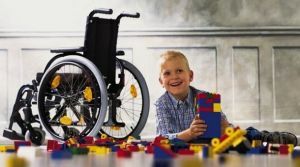 Cerebral Palsy( cerebral palsy - decoding) is a combination of disorders that develop at the time of delivery or during the postpartum period due to damage to the brain structures and are characterized by motor disorders and mental disorders.
Cerebral Palsy( cerebral palsy - decoding) is a combination of disorders that develop at the time of delivery or during the postpartum period due to damage to the brain structures and are characterized by motor disorders and mental disorders.
This pathology is not congenital. Diseases that unite pathology, do not progress, but some characteristics tend to manifest itself with time to the greatest extent.
cerebral palsy leads to disability due to significant neurologic impairments and muscle contractures that interfere with normal social and labor adaptation. In the classification of diseases ICD-10, cerebral palsy is under the code G80.
Contents
- Pathogenesis of the disorder
- Why does the disease occur?
- Species and stages of cerebral palsy
- Clinical picture
- Diagnosis
- Therapeutic package
- Auxiliary devices
- The prognosis is disappointing, but. ..
Pathogenesis of
disorders Changes in the nervous system occur due to hypoxia and metabolic disorders that directly affect the development and work of the brain.
The severity of structural defects in the brain is determined by the variety of harmful factors and the period of their action. In 30% of children with this diagnosis, there are such pathologies of the brain as micro-polygism, pachigiria, portentsefalia, agenesis of the corpus callosum, which are a consequence of brain damage in the early period of embryonic development.
In many cases, focal anomalies are observed - atrophic lobar sclerosis, atrophy of basal ganglion cells and visual cusp, pituitary gland and cerebellum. 
This disorder is characterized by a significant localized atrophy of the frontal lobe, a deficiency in the development of the cerebral cortex, the midbrain.
Due to the defeat of the basal ganglia and the visual hillock, myelin fibers proliferate with an annular arrangement near the vessels.
In the cerebellum, there is an inadequate myelination of the pathways and a change in nerve cells.
Why does the disease occur?
The main factor determining the occurrence of cerebral palsy is the damage or inadequate development of one of the brain zones. There are more than 100 reasons why children with cerebral palsy are born. They are classified into groups:
- , the causes associated with the course of pregnancy;
- reasons related to the moment of birth;
- causes associated with the period of adaptation of the newborn to environmental conditions in the first month of life.
Practice shows that almost half of babies with this diagnosis are born prematurely. Such babies are very vulnerable due to underdevelopment of organs and vital systems.
The most common risk factors are:
- large child size;
- incorrect fetal presentation;
- the narrow pelvis of a woman;
- premature detachment of the placenta;
- Rhesus-conflict;
- artificial stimulation of the generic process;
- acceleration of labor with the use of the method of perforating the amniotic bladder.
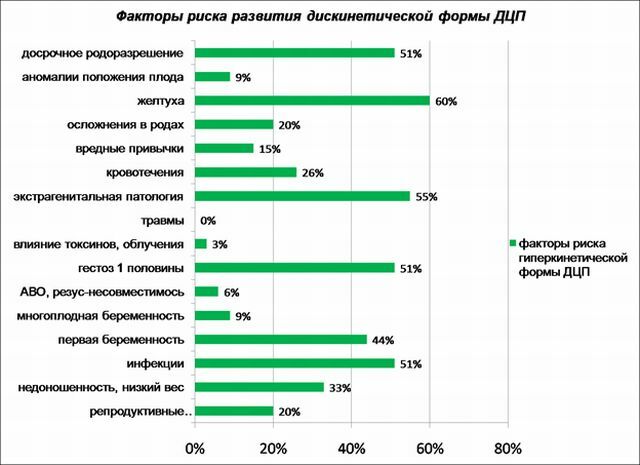
In the postnatal period, the causes of CNS involvement can serve as:
- severe infections - acute herpes, meningitis, encephalitis;
- lead intoxication;
- head injury;
- oxygen starvation of the brain due to obstruction of the respiratory tract.
Types and stages of cerebral palsy
Cerebral palsy are different depending on the area of brain damage. Allocate the following forms of cerebral palsy:
- Spastic diplegia .The part of the brain responsible for the motor activity of the hands and legs is affected. It is characterized by complete or partial paralysis of the extremities.
- Double hemiplegia .Both hemispheres of the brain are affected, which increases the muscle tone. This is the most severe form of the disease. Children with this diagnosis can not move, sit down, stand and even hold the head.
- The hemiparetic form of .One hemisphere of the brain with cortical and subcortical structures is affected. It is accompanied by muscular one-sided paralysis.
- Hyperkinetic form of .Affected subcortical structures. This causes involuntary movements. This form is often combined with spastic diplegia.
- The atonic-astatic form of .The cerebellum is affected. It manifests itself in the violation of coordination of movements and muscle atony.

It is also common to distinguish several stages of the disease:
- early - to half a year;
- initial chronically-residual - up to two years;
- final residual - from two to four years and older.
Clinical picture of
In many cases, the signs of infantile cerebral palsy are noticeable immediately after the onset of the baby's birth, but sometimes the symptoms manifest gradually and in this situation it is very important to recognize them.
The main signs are:
- impairment of motor activity - the baby does not hold the head for a long time, does not turn over, does not crawl and does not walk;
- reflexes of the nursing period persist for a long time;
- muscle tone is increased or vice versa, is lowered, so that the arms and legs take unnatural-forced positions;
- presence of convulsive seizures;
- disturbances in the work of the organs of sight and hearing, as well as speech;
- disorientation in the surrounding space;
- lagging behind in mental and emotional development;
- disorder of the digestive tract and urinary tract.
Despite the fact that it is rather difficult to diagnose cerebral palsy in the early period, it is extremely important to consult a specialist without delay if there are such signs:
- at the age of one there is no reflex of blinking in response to a sound stimulus;
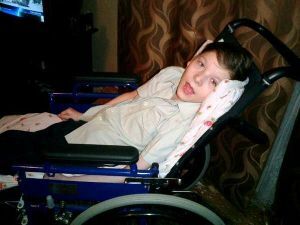
- the child does not turn the head to sound at the age of four months;
- at the same age the child does not pull pens to toys;
- at seven months old the baby can not sit alone;
- a year the child does not utter the first words and does not go;
- the child uses only one hand;
- presence of seizures;
- movement inhibited or opposite, sharp;
- marked strabismus.
The diagnosis of
cerebral palsy can not be detected at the first time after the birth of a child, therefore it is required to undergo systematic examinations for the timely diagnosis.
The exact final diagnosis is made only towards the end of the second year of life in the presence of severe motor disorders, since at an early age they can be worn transient. The purpose of the diagnosis is to observe the deviations in the child's physical and mental development.
Complex diagnostics is carried out on the basis of such methods:
- magnetic resonance imaging;
- computed tomography;
- ultrasound of the brain;
- collection of anamnesis for the child's and mother's diseases, pregnancy;
- physical examination to assess the state of hearing, vision, muscle tone, reflexes;
- tests and development tests - determine the latent form of pathology;
- additional examination for the detection of concomitant diseases.
It is also necessary to differentiate cerebral palsy from hereditary diseases, chromosomal syndromes, tumors affecting the nervous system, and neuroinfections.
Complex of therapeutic measures
Treatment of cerebral palsy is carried out from the moment of diagnosis to the end of the patient's life. The primary goal of therapy is to maintain and restore all impaired functions.
 At preschool age, it is very important to make maximum efforts to rehabilitate the child. The importance of the rehabilitation process in cerebral palsy is related to the fact that in the process of active brain development, the performance of lost and impaired functions can be assumed by healthy departments.
At preschool age, it is very important to make maximum efforts to rehabilitate the child. The importance of the rehabilitation process in cerebral palsy is related to the fact that in the process of active brain development, the performance of lost and impaired functions can be assumed by healthy departments.
Treatment in this case will be symptomatic. The main methods will be aimed at maximizing the motor skills available for a particular patient.
Complex treatment is based on the following principles:
- The most effective method is manual therapy .This method is aimed at bringing the muscle tone back to normal. The massage has a beneficial effect, the procedures help improve blood circulation and lymph flow, activate metabolic processes in tissues and work of internal organs. With massage, the spastic muscles relax and stimulate weakened muscles.
- Therapeutic gymnastics improves coordination of movements. Classes should be regular and carried out throughout the life of the patient, only in this case it will give positive results. Also, a favorable effect can be achieved with the help of training on a special simulator.
- Physiotherapy consists of such procedures as myostimulation and electrophoresis. Electroflexotherapy is also considered an effective method. All methods of physiotherapeutic treatment are aimed at improving the muscle tone, improving the coordination of movements, the formation of correct speech and diction. However, it is worth remembering that such treatment is contraindicated in the presence of convulsive seizures.
- Medical treatment is performed with the purpose of stimulating brain activity, improving the process of metabolism in the brain and muscle tissues, normalizing intracranial pressure, reducing neural reflex excitability and improving the child's mental development. Among the prescribed drugs can be identified: Cerebrolysin, Aminalon;Pyriditol, Pyrogenal, vitamin B12, glutamic acid.
- Surgical treatment of is an operation on the brain. Such operations are necessary to improve motor activity in the case of an irreversible process of limited mobility in the joints. As a result of surgical manipulation, brain structures that provoke neurological disorders are destroyed, among them: increased muscle tone, abnormal motor activity of the legs and hands, involuntary movements.
- Classes with the speech therapist is conducted with the purpose of development and correction of auditory and visual perception, as well as recsular and speech analyzers. The program of classes is built taking into account the age features, the severity of the defeat of the articulatory apparatus, the stage of delay of pre-speech and speech development, mental and mental characteristics, and the general physical state of the organism.

- To unconventional, but very effective methods of treatment can be attributed hippotherapy .Hippotherapy is a method of therapeutic riding. In this case, a positive result is achieved by stimulating the development of respiratory reflexes. When the child sits on horseback, the correct posture is formed, and the balance holding skill is developed. Also this method promotes training and strengthening of muscles, eliminating its disproportionality, regulating muscle tone, increasing the amount of motor activity in the joints.
- Also to unconventional methods include balneotherapy, aquatherapy, and frostbite.
Very often, in the hope of returning to their child's health, parents turn to unproven methods of treatment. There are cases when methods of fasting or phytotherapy, i.e., treatment with herbs, were used. Phytotherapy, as a rule, is carried out by wrapping, taking herbal baths and taking medicinal tinctures.
Auxiliary devices
Special adaptations to the child with infantile cerebral palsy are necessary in all spheres of life. There are a lot of them, but the most necessary ones are:
- Wheelchair .Used for children with musculoskeletal disorders who can not move without help.
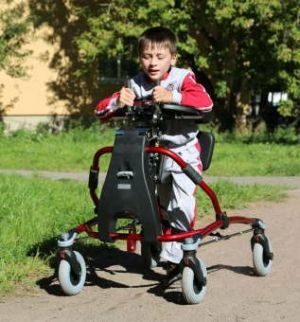
- The walkers for children with cerebral palsy help to keep the balance to the child who can walk himself.
- Verticalizer .The device for holding the vertical position.
- Seat .It is a kind of chair, equipped with special straps, which help to maintain the correct position of the body.
- Table and chair .Specially equipped pieces of furniture, which also allow you to hold the desired position.
- The bicycle for children with cerebral palsy has three wheels. Thanks to the "ride" on such a bicycle, there is a relaxation and strengthening of the muscles, as well as the development of leg mechanics.
- Simulator .Also used to strengthen muscles.
- Armchair-seat for the bathroom .Auxiliary devices for bathing a child.
- Armchair-WC .Armchair with removable device.
- Orthosis .Corrects the position of the joints and helps in developing the skills of proper movements.
The prognosis is disappointing, but. ..
cerebral palsy is not treated today. But such a diagnosis is not a verdict. With properly chosen tactics of treatment, regular sessions of physiotherapy exercises, you can achieve maximum adaptation of the child to normal life.
With minor damage to mental activity, such babies can lead a practically full life on a par with healthy children.
Depending on the degree of brain damage, timely diagnosed and with the correct successful treatment, the disease can have minimal impact on the life of the baby.
If the intellect is not violated, children with this pathology are trained in ordinary schools, master the professions, achieve success in sports and other activities.
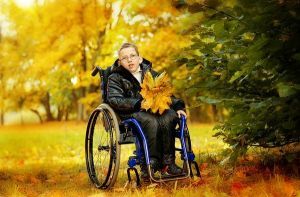 With regard to disability, the category is assigned if the child has certain restrictions in life, which determine the need for social assistance and protection.
With regard to disability, the category is assigned if the child has certain restrictions in life, which determine the need for social assistance and protection.
In order to reduce the risk of developing this disorder in a child, during pregnancy it is required to systematically undergo a comprehensive examination. It is also necessary to register on the third month of pregnancy.
It is very important to adhere to a healthy lifestyle, which involves the rejection of bad habits, proper nutrition, the use of essential vitamins, a full-fledged sleep, walks in the fresh air.
If infectious diseases occur, timely treatment is necessary.


